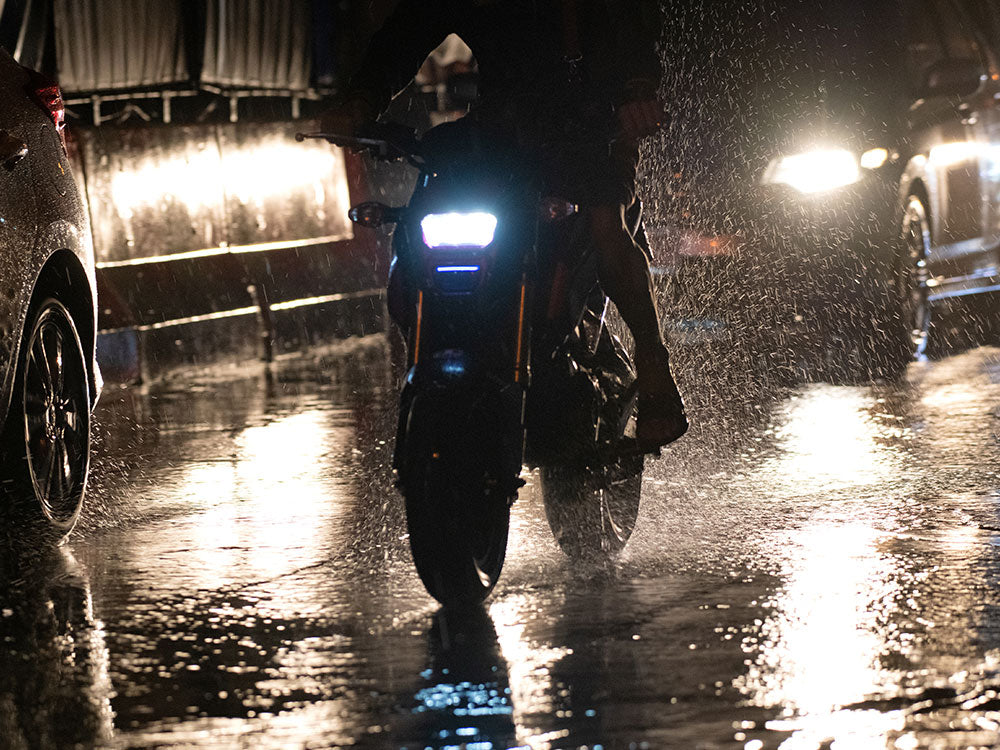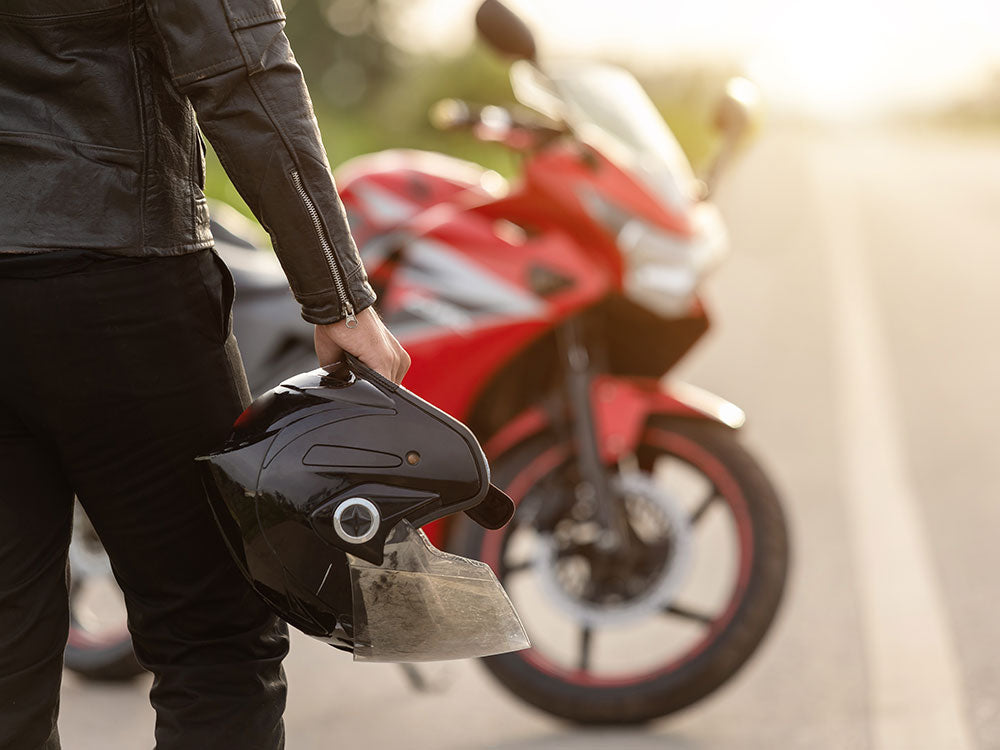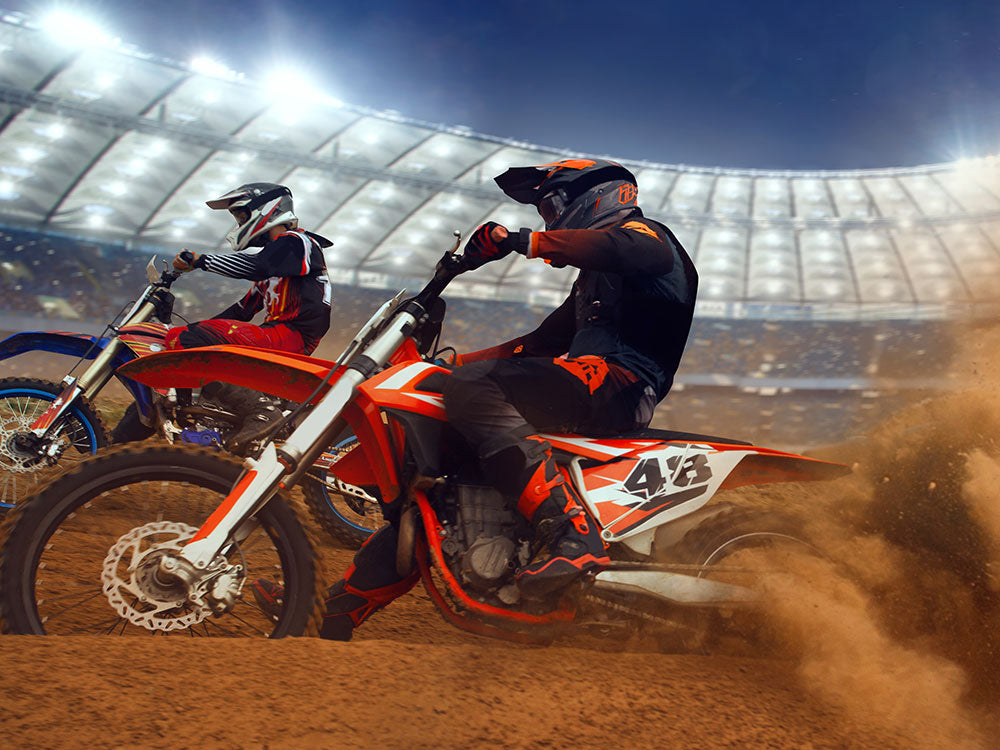Table of Content
1. Introduction

Nobody likes to ride their motorcycle while it is raining. In clear weather, it is easier to discern your surroundings, maintain your balance, and cruise at high speed. Plus, you and your motorcycle get to stay dry for the duration of a trip. Any sensible motorcyclist checks the weather forecast ahead of time and plans trips on days when there is a low chance of rain.
Riding your motorcycle during a downpour is a different, more challenging experience. Especially in regions that do not see much rainfall year-round, asphalt roads becoming soaked causes oily residue from automobiles to coat the surface, making them more slippery than usual. The slick surface means that your motorcycle’s tires will have less traction and are more susceptible to skidding if you are racing or turning too fast. Plus, visibility becomes low due to the sun being covered by clouds and mist or fog obscuring the road ahead.
Though it is recommended you avoid riding your motorcycle while it is raining if possible, many riders may need to brave the bad weather conditions to commute to work or deal with an emergency. This article provides ten tips on how to safely ride your motorcycle in rainy weather.
2. Tips for Riding a Motorcycle in the Rain
2.1. WEAR APPROPRIATE RIDING GEAR
Because the temperature lowers during rainy weather, you must dress warmly. Remember to wear waterproof and insulated motorcycle clothing, including a jacket, long pants, gloves, and boots. These riding gear must be durable enough to protect your body from severe injuries should you be flung from your motorbike. To help provide extra warmth, you may want to wear layers or a heated vest underneath your clothing. To ensure that you have an unobscured view of the road, make sure that your motorcycle helmet’s visor or goggles can defog without frequently needing to wipe the moisture off the surface.
2.2. WATCH OUT FOR PUDDLES & SLICK SPOTS
The longer it rains, the less dry surfaces there will be on the road. Though traction will decrease slightly on all wet surfaces, it is best to avoid puddles and slick spots since they may cause your tires to skid. Puddles usually pool around corners, along sidewalks, or in potholes. You may not be able to tell how deep they are, plus driving into them may cause your tires to be halfway or fully submerged. Try to skirt around the edges of the puddle if possible. Slick spots may include oil leaks, painted lines, tar snakes, manhole covers, etc. If you notice any unnaturally shiny or reflective surfaces, try to go around them or slow down when going over them.
2.3. RIDE BELOW THE SPEED LIMIT
Because rain will cause the roads to become slippery, it is not safe to ride along highways or city streets above the speed limit. Especially for motorcycles, the low traction and unstable surface will make it more difficult to maintain balance or make narrow turns. Avoid pulling the throttle or accelerating in sudden bursts since it could cause the tires to lose traction or slip if you happen to be over a slick spot. Even if the road is straight and there are no vehicles immediately in front of you, do not increase speed past the speed limit.
2.4. CHECK TIRE PRESSURE
As the air temperature and pressure change as rainy weather approaches, it could cause your tires to deflate slightly. Especially if you are heading out in rainy weather, you should check your tire pressure before you embark. If you rode for an extended period in rainy weather, you should check the tire pressure after you arrive at your destination or return home. Keep in mind that cold weather conditions will require you to take more time to re-inflate your tires to the minimum psi. If possible, carry a portable air pump with you that is either manual or electrical.
2.5. INCREASE BUFFER SPACE BETWEEN VEHICLES
If you brake while it is raining, it will take more time and distance for your motorcycle to slow down and come to a stop. The lack of traction results in the tires taking several more seconds to catch onto the road, and your motorcycle will slide forward several more feet before stopping completely. If you were to brake suddenly while directly behind another vehicle, it would likely result in a collision. Try to put more space between you and the vehicle in front of you so that you have more time to apply the brakes.
2.6 MAKE SURE YOU ARE VISIBLE TO OTHER VEHICLES
If there is heavy rainfall, the road may become blanketed in a thick fog or mist, making it difficult for you and other drivers to spot each other, except at close distances. So that you are easier to spot, make sure to wear bright and reflective clothing to contrast with the dark and gray environment. Also, check the headlight, brake lights, and turn signals to ensure the bulbs are working and are shining brightly enough that they can be seen from a reasonable distance.
2.7 BE CAREFUL AT INTERSECTIONS AND ROUNDABOUTS
At intersections and roundabouts, there tends to be more traffic during rainy weather due to the poor road conditions slowing the flow of vehicles moving through. At intersections, it may be difficult to see past the vehicles in front of you to check for hazards, larger vehicles around you may be close together, and the road may have oil slicks. At roundabouts, you will need to be careful of any other vehicles entering or exiting, avoid the puddles along the edge of the circle, and the less traction while turning.
2.8 8AVOID RIDING ALONG THE EDGES OF THE ROAD
Unlike most highways and city streets, the edges or shoulders along the sides of the road have dirt or gravel surfaces rather than being made of asphalt. Dirt and gravel that becomes wet become unstable surfaces that offer little traction and may cause your motorcycle to skid. If you need to stop on the side of the road, make sure to slow down and walk your motorcycle over to a spot out of the way of incoming traffic.
2.9 MAKE SURE YOU KNOW ALTERNATE ROUTES
Depending on the severity of a storm, heavy rainfall can cause a road or highway you normally take to become flooded, or an accident could have occurred that resulted in a route being temporarily closed. Before leaving home, look up other possible routes you can take to get to your destination by using a GPS or looking at a map. Knowing which streets or exits will take you to alternate paths beforehand will help you save time.
2.10 COVER YOUR LUGGAGE
If you need to carry belongings in saddlebags or a backpack, such as your electronics, school supplies, or work documents, you will need to protect them from getting soaked. You should either place a rain cover over your luggage or place your items vulnerable to water damage in plastic bags. Depending on the kind of motorcycle luggage you use, their exterior should be constructed out of durable, weather-resistant materials that are sealed tight and should keep rain from seeping inside.
3. CONCLUSION
To be able to operate a motorcycle, riders need to be skilled and cautious when maneuvering around traffic and avoiding getting into accidents. When it is raining, riders must be even more mindful of their surroundings, decisions, and the condition of their motorcycles. Rain makes road conditions much more dangerous than before, and even a single mistake could result in a collision. After reviewing these tips on how to ride a motorcycle in the rain, remember that you need to follow every single one to ensure a safe and comfortable riding experience. Though rainy weather can make riding a motorcycle difficult and unpleasant, it is not impossible.












Leave a comment
All comments are moderated before being published.
This site is protected by hCaptcha and the hCaptcha Privacy Policy and Terms of Service apply.